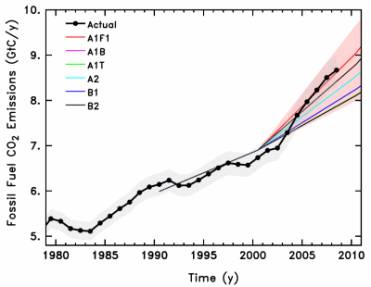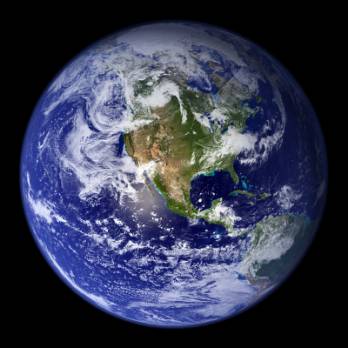| Research • Education • Advocacy • Sustainability |
|
| Listening – Research |
| Understanding – Videos |
| Education – Publications |
| Teaching – Presentations |
| Zero Emissions – Futurity |
 |
|||||||||||||||
| Earth in the balance. | Photo © Thomas Vogel | ||||||||||||||
Zero emissions, zero regrets“If global warming is to be stopped, global CO2 emissions must eventually decline to zero. This essay argues that courageous leadership is critical if a great transformation towards a low-carbon global society with near-zero emissions of CO2 and other long-lived greenhouse gases is to succeed. The rough copy WANTED: LEADERSHIP (9 pages, 1.9 MB) was initially drafted following the 2009 UN Climate Change Conference in Copenhagen which exhibited a striking absence of leadership. The paper was subsequently translated into Spanish and published in FUNGLODE: Luetz, J M (2010) Se Busca Liderazgo: Cambio Climático post-Copenhague 2009. Revista de la Fundación Global Democracia y Desarrollo (FUNGLODE). Vol 7. No 33. (Marzo/Abril). Páginas 46-53. (8 pages, 3.1 MB). Wanted: Leadership ▲The climate system responds very slowly. This is one reason why climate change is often not understood as a matter meriting emergency intervention. Writing about climate change post-Copenhagen 2009 can no longer be mainly about climate science. Writing about climate change post-Copenhagen 2009 now appears to be mainly about leadership. Given that a time lag (climate system inertia) delays impacts by several decades, by the time the fallout from laissez-faire fossil fuel emissions has been made manifest, the window for pre-emptive action will have already closed. Leadership must see tomorrow today. Only a swift and comprehensive transition to a decarbonised global society with near-zero emissions of CO2 and other long-lived greenhouse gases can stop global warming and become the foundation for a friendly, equitable and livable future. Inspired leadership will be indispensable if this transition is to succeed peacefully, sustainably and globally. As Nelson Mandela has said in Lessons of Leadership: “Courage is not the absence of fear – it is inspiring others to move beyond it.” (1) Facing the future ▲The manner in which climate change has made its debut in the international arena in recent years is reminiscent of what the German Philosopher Arthur Schopenhauer (1788-1860) said was the inevitable lot of all truth. He said: “All truth passes through three stages. First, it is ridiculed. Second, it is violently opposed. Third, it is accepted as being self-evident.” (2) Over recent decades, climate change gradually worked its way from ridicule and opposition to quasi-universal scientific assent. The Fourth Assessment Report of the Intergovernmental Panel on Climate Change (IPCC) which took 2,500+ scientists and expert reviewers from 130 nations six years to compile in four Nobel Peace Prize-winning volumes, can be regarded as the final nail in the coffin of a protracted climate change debate: “Warming of the climate system is unequivocal.” (3) The huge mountain of peer-reviewed scientific evidence amassed in the last two decades has charged humanity to take robust action on climate change, and to translate the scientific consensus into decisive political action and comprehensive societal reform. Since systems, structures and markets conspire to maintain the status quo and prevent change, unprecedented leadership is needed to stave off what may be the gravest threat ever to have faced humanity. (4) Recent attempts by spin doctors and fossil fuel-funded interest groups to discredit the IPCC in the media over minor errors do not detract from the unchanged truth: the IPCC’s assessment reports remain authoritative and reflect the state of scientific knowledge very well. (5) Why then are today’s leaders failing to take serious action on climate change even when charged with a solid, science-dictated mandate? This article argues that at its core the current climate crisis is primarily a leadership crisis. While political leaders are gradually waking up to the enormity of the challenge ahead, serious action on the problem has yet to be taken. Climate change challenges ▲Climate change is hard to tackle. We all know this. Many reasons combine. I will briefly discuss three. First, it is largely pleasant to do the things that cause climate change. Second, greenhouse gases are invisible: out of sight, out of mind. Third, there is a time lag: today’s pollution is tomorrow’s pain. As shown by figure 1, the extremely slow decay of CO2 in the atmosphere means that the warming effect literally lasts for decades, centuries, even millennia. After emission by fossil fuel burning, the fraction of CO2 remaining in the air declines rapidly at first, but 1/3 remains in the air after a century and 1/5 after a millennium. (6) With significant global warming already committed to based on past emissions, climate change consequences are largely foisted off on future generations. This intergenerational inequity issue is at the core of why today’s emitters can continue to use the atmosphere with impunity as a free open sewer for their CO2 emissions: most victims simply have not been born yet.
A few weeks ago I was invited to speak on climate change at a conference in Bangkok, Thailand. Together with my audience I reflected on my flight to Bangkok as a real life example of how human actions cause global warming. I wanted to calculate for my listeners the climate change burden from my trip and demonstrate that climate change is anything but abstract. To calculate my per-capita emissions from air travel I needed to know that 1 ton of jet fuel burned produces 3.157 tons of CO2. (7) To find out the total jet fuel consumption and number of passengers with me on the plane I asked the captain of my Thai Airways 747-200 flight. Luckily his availability and detailed answers enabled me to accurately calculate my personal carbon footprint from the journey: in total my per-capita CO2 emissions released to the atmosphere from the roundtrip journey to Bangkok came to 1.78 tons. (8) After this calculation I reflected with my audience on the fact that hundreds of years from now a significant fraction of CO2 from my Bangkok flight would still be left in the atmosphere: 100 years from now there would still be a fraction of ~33% (0.58t CO2) airborne, and 1,000 years from now a fraction of ~19% (0.33t CO2). To be clear: these figures reflect my per-capita contribution, not the total emissions from the flight. The upshot is that my per-capita contribution of 1.78 tons of CO2 emissions combines with that of millions of people around the world whose collective actions ratchet up global warming both now and for centuries to come. This is where the problem of climate change begins, and this is where it needs to be addressed. Actions taken or not taken today will have a profound bearing on our children, grandchildren and future generations. Let’s understand why this is worrying. Evolving climate science ▲In light of ongoing population growth and global economic development it is hardly surprising that the recent rise in atmospheric CO2 is steep and relentless. Since the industrialisation began in the 1800s, atmospheric CO2 concentrations have climbed to 390 parts per million (ppm). (9) This is more than 110ppm above its natural pre-industrial level. Placed in historical context today’s CO2 concentration of 390ppm (as of March 2010) is higher than at any other time during the last 800,000 years, and potentially the last 3 to 20 million years. (10) But not only do emissions continue to rise, the increase rates also continue to go up. In other words, as population growth and economic development combine, more and more CO2 is being emitted faster and faster. While in the 1990s CO2 levels increased at a rate of 1.5ppm/year, CO2 levels are now growing by 1.9ppm/year (see figure 2). This rate increase is more than 10 times faster than the highest rate detected in ice core data. Total CO2 emissions from fossil fuel burning in 2008 were 40% higher than those in 1990, with a 3-fold acceleration over the past 18 years. Global CO2 emissions from fossil fuel burning are thus tracking near the highest scenarios considered so far by the IPCC. (11)
The consequences have long been established: CO2 concentrations on that order of magnitude are pushing up global average temperature by 0.2°Celsius per decade. Not surprisingly, ensuing climate changes on that scale are progressively phasing in a new era of climatic upheaval where numerous impacts arise through extreme weather events. In its Fourth Assessment Report the IPCC stated that climate change would drive more heat waves and droughts over wider areas, trigger more frequent heavy precipitation events, and generate more intense tropical cyclone activity. Moreover, species are being wiped out at the fastest rate on record (faster than they can evolve), plus all of the above is picking up pace. (12) But there is more at stake: possibly the greatest of all threats linked to climate change is the accelerated disintegration and possible eventual meltdown of the Greenland and West Antarctic ice sheets. One of the reasons for alarm is that ice sheet disintegration, unlike ice sheet formation, is a non-linear process and can happen very rapidly, potentially triggering swift and irreversible sea level rise on the meter-scale. Already things have been speeding up. Sea level has risen more than 5cm over the past 15 years (3.4mm/year), about 80% higher than IPCC projections from 2001. (13) According to The Copenhagen Diagnosis, a recent study published by a group of leading climate scientists, global sea level rise may be poised to exceed 1 meter by 2100, with a possible rise of up to 2 meters presently considered an upper limit. Beyond 2100, sea level will continue to rise for centuries even if global temperature can be stabilised, since it takes that much time for the oceans and ice sheets to fully respond to a warmer climate. Projections show that by 2300 sea level rise of up to 5 metres may be expected, implying the loss of coastal cities and island states. (14) The question is not so much “if” but “when.” But let’s be clear. The issue is not when this is to happen. The real question is when is this to be stopped by today’s generation of leaders? A few years ago the United Nations Human Development Report warned that time for action was running out, sounding a clarion call for stalwart political leadership. It said: “There is a window of opportunity for avoiding the most damaging climate change impacts, but that window is closing: the world has less than a decade to change course (15) ... The starting point for action and political leadership is recognition on the part of governments that they are confronted by what may be the gravest threat ever to have faced humanity ... Government leaders need to send a clear signal that the battle against climate change has been joined – and that the future will look different to the past.” (2007/2008 UN Human Development Report) (16) Larger-than-life leaders ▲It would be premature to delve into a discussion of the needed political actions without pausing to reflect on the breed of political leaders needed to legislate them. As we’ve seen there are no rewind buttons for running down emitted greenhouse gas stocks which remain in the Earth’s atmosphere for a very long time. The Fourth Assessment Report of the IPCC makes this clear: “Both past and future anthropogenic CO2 emissions will continue to contribute to warming and sea level rise for more than a millennium, due to the time scales required for the removal of this gas from the atmosphere.” (17) Elsewhere the report notes that sea level rise caused by thermal expansion (warmer water occupies more space) will “continue for many centuries due to the time required to transport heat into the deep ocean.” (18) In other words, humanity is committed to rising temperatures and rising sea levels for many decades to come, even if serious political measures to curb emissions were legislated with immediate effect. The 2007/2008 UN Human Development Report notes: “Even stringent mitigation measures will not materially affect average temperature changes until the mid-2030s – and temperatures will not peak until 2050. In other words, for the first half of the 21st century the world in general, and the world’s poor in particular, will have to live with climate change to which we are already committed.” (19) In light of such realities it is apparent that viewing the political process in terms of electoral cycles which typically span time horizons of 4-8 years is vastly inadequate. What the world needs is political leaders who can look beyond their terms of office in government, beyond their political careers, beyond their own lifetimes and beyond their grandchildren’s generations. Larger-than-life-leadership is a matter of justice. (20) On 10 May 1940, Winston Churchill became the British Prime Minister. Knowing that the world faced a lethal storm from fascism he was frank to address his Cabinet on 13 May 1940 with words that have become famous the world over: “I have nothing to offer but blood, toil, tears and sweat.” (21) His years in office saw his electoral promise fulfilled — and the world liberated from fascist oppression. To address today’s storm of climate change will require similarly bold leaders who dare their societies to forego short-term gratification for long-term survival. Sustainable emissions pathways will have to be followed not for years but over generations. The tasks will be difficult, the measures inconvenient, the costs high, the sanctions unpopular, the restrictions unpleasant, the outcomes uncertain and the opposition severe. But measured against the criterion of “justice” it is evident that the present political path of short-term incrementalism is failing to deliver the “big changes and ambitious new policies” which the Executive Director of the United Nations Environment Programme, Achim Steiner, asserts the world urgently needs. (22) Expressed in diplomatic language, today’s political leaders are not adequately addressing the issue of climate change. Three constituencies are at highest risk because the world’s leaders do not hear their cries — the poor, future generations, and millions of creatures implied by the term “biodiversity.” Justice demands urgent legislation in key areas which mitigate climate change through a change of direction.
One home, one family, one future ▲“In a world that is so divided by inequalities in wealth and opportunity, it is easy to forget that we are part of one human community. As we see the early impacts of climate change registering across the world, each of us has to reflect what it means to be part of that family ... We can – and must – work together to ensure that [it] does not throw human development into reverse gear.” Planet partner! Perhaps no other photo depicts the sheer necessity for planetary partnership as pictographically as NASA’s “Blue Marble” photo — the most detailed true-colour image of the Earth to date. (24) Scientists and visualisers stitched together months of observations of the land surface, oceans, sea ice, and clouds into a seamless, true-colour mosaic of every square kilometre of our planet — our shared home. This blue planet is covered by a very thin layer of atmosphere. The astronomer Carl Sagan described it like this: “If you had a globe covered with a coat of varnish, the thickness of that varnish would be about the same as the thickness of the Earth’s atmosphere compared to the Earth itself.” (25) This fragile layer is now filling with pollution. With more than 6.8 billion individuals spread out across more than 190 countries, the Earth’s atmosphere does not differentiate greenhouse gases by countries of emission. One tonne of greenhouse gases from the United States carries the same weight as one tonne of greenhouse gases from the EU or China — every milligram is absorbed by the same thin layer of atmosphere which all people on Earth collectively own. The world is one, the world is seamless. In Bangladesh, 80% of flooding is caused by rainfall in India. (26) Numerous studies have shown that even modest rises in sea level would inundate tens of thousands of square kilometres of land and displace up to 70 million people in Bangladesh. (27) Scientists predict, that given the proximity of Bangladesh to India and the large land area that would be inundated, it is likely that the bulk of Bangladeshi climate exiles will end up being migrants in India. (28) Stated simply, India’s rains are Bangladesh’s floods — Bangladesh’s climate refugees will be India’s migrants. — China’s coal-fired power stations will fuel America’s hurricanes — America’s fuel-inefficient cars will ratchet up China’s floods. Cross-cutting collaboration is not a contingency but an imperative. Since we live on one planet as one family of nations, collectively sharing one atmosphere, it is time to come together as one species and forge one robust response. The problem is intricate. The fact that each country’s emissions are simultaneously every other country’s climate liability makes climate change mitigation matters different and more difficult to resolve than other policy challenges. The question of “carbon debt” from historical emissions does not make things easier. But it’s not impossible to change perspective. In previous millennia the predominant preoccupation of sovereign States revolved around owning land. In the third millennium it will be this: who owns the sky? Who has the “right” to pollute the atmosphere to the detriment of all? Since this has consequences for all peoples on our one planet, it is time to put petty national interest aside and adjust our global political atmosphere to our global physical atmosphere. The Earth can’t do bail-outs. Good news and bad news ▲The bad news first: global warming cannot be reversed due to the long life-time of CO2 in the atmosphere. This is because CO2 cannot be extracted from the atmosphere in massive amounts. (29) Invariably this implies that past, present and future emissions will lock in global temperatures both now and for thousands of years to come. According to a recent study, without significant mitigation, global mean warming could reach as high as 7°Celsius by 2100. (30) Now the good news: global warming can be completely stopped. The temperature at which global warming will finally stop depends mainly on the total amount of CO2 released into the atmosphere since industrialisation. (31) This is again due to the long life-time of CO2. Therefore, if global warming is to be completely stopped, global emissions must eventually decline to zero. The sooner emissions stop, the lower the final warming will be. Over recent years the question “how hot is too hot?” has been rigorously studied: The most widely supported policy goal today is to limit global warming to at most 2°Celsius above pre-industrial levels. Many nations have publicly accepted this 2°Celsius limit, recognising that to cross this critical threshold would cause “dangerous” climate change which would spiral dynamically out of humanity’s control. The Synthesis Report of the Copenhagen Climate Congress, the largest climate science conference in 2009, concluded: “Temperature rises above 2°C will be difficult for contemporary societies to cope with, and are likely to cause major societal and environmental disruption through the rest of the century and beyond.” (32) The reality that CO2 cannot be drawn down from the atmosphere makes a cumulative CO2 budget for the whole world an attractive consideration. Such an agreed global budget could then be divided and distributed among countries, for example on the basis of equity principles. (33) A number of scientific studies (e.g. figure 3) have calculated global emissions trajectories that would successfully limit global warming to 2°Celsius. According to one study, if a total budget of 1,000 Gigatons of CO2 (34) is emitted for the period 2000-2050, humanity would have a 3 in 4 chance of limiting global warming to 2°Celsius. (35) But with 350 Gigatons already emitted during 2000-2009, this leaves only 650 Gigatons for the period 2010-2050. At today’s emissions rates this budget would be used up within 20 years.
Action is urgent: any delay in bending down the emissions curve drastically increases the speed and depth of future emissions cuts. (36) The important point to remember is this: ongoing population growth implies that more and more people will have to emit less and less CO2 faster and faster to remain within the cumulative budget. To keep temperatures below 2°Celsius will mean that by 2050, annual per-capita emissions very likely will need to be below 1 ton. This is 80-95% below the per-capita emissions in developed nations in 2000. Let’s connect the dots. Remember the per-capita CO2 emissions from my flight to Bangkok discussed earlier? The CO2 emissions from this single journey are nearly twice the allowable annual per-capita emissions in the year 2050 if framed by a cumulative global budget. If anything is clear from the math it is that the world’s present development paradigm that rewards profligate consumption and waste is a dead end. What we need is a revolution of our thinking, a revolution of the economy, a revolution of our technology, a revolution of our imagination, and a revolution of political action and human solidarity. This is the climate change challenge that history is now presenting to this our generation. This challenge is so formidable that it is worthy of our very best effort. We are the generation history has chosen to live up to this enormous opportunity. May it awaken the leaders in all of us! Conclusion: acting in concert ▲One final thought. A few days ago I went to listen to a classical concert. Since I reached the venue early I took my seat and watched the musicians of the symphony orchestra warm up and get ready. I listened intently as these professionals tuned their instruments and performed finger exercises — string, brass, woodwind, and percussion. The sounds emanating from the stage were a jumble of razzmatazz. Each oboe, flute, violin, clarinet, horn or trumpet was effectively drowned out by general pandemonium. But when the maestro stepped up, all dissonance died down. The music that followed moments later was the most concordant, mellifluous, harmonious, exquisite, symphonious, poetic, graceful and grand composition I ever heard — the kind that causes your heart to beat faster and your eyes to fill with tears — intricate beauty — beyond words. That’s when the penny dropped. I thought of the Copenhagen 2009 climate change conference and the 45,000 people who had travelled there to reach a deal on climate change. The stage was set, the house packed, the seats sold-out, the concerto ready and the atmosphere buzzing with excitement. The world waited and watched the stage in electrified anticipation while all sorts of sounds were coming from the platform. Everybody kept tuning and warming up, but the maestro never came. Instead, to everybody’s shock and disbelief, the musicians packed up, then everybody left. The concert never happened. Truth be told, the world is still waiting for that concert to finally begin. Where are the stalwart, passionate leaders who dare to step up to the climate change challenge and lead the world with courage and commitment to change course? As the famous German poet (37) has said, — boldness has genius, power, and magic!
References ▲Endnotes in this essay refer to sources referenced in the English draft text WANTED: LEADERSHIP – Climate Change Leadership post-Copenhagen 2009 (9 pages, 1.9 MB). The paper was subsequently translated into Spanish and published in FUNGLODE: Luetz, J M (2010) Se Busca Liderazgo: Cambio Climático post-Copenhague 2009. Revista de la Fundación Global Democracia y Desarrollo (FUNGLODE). Vol 7. No 33. (Marzo/Abril). Páginas 46-53. (8 pages, 3.1 MB) |
|||||||||||||||
| Except for photos, logos and where noted, works on this webpage are licensed under a Creative Commons License |
|




